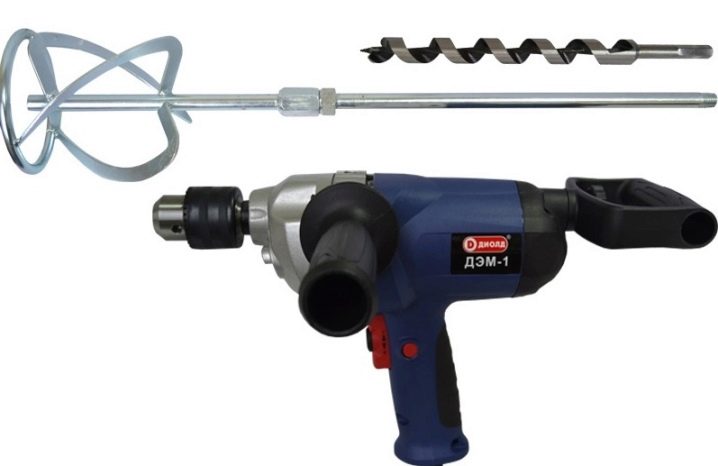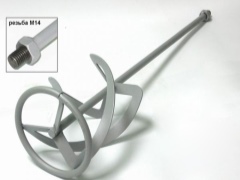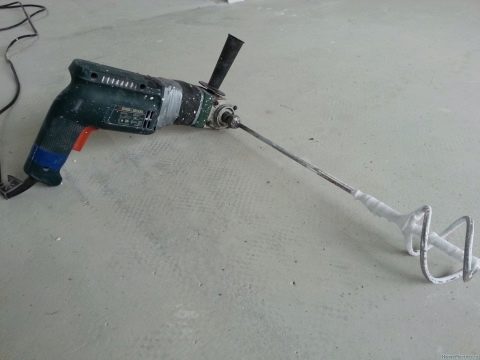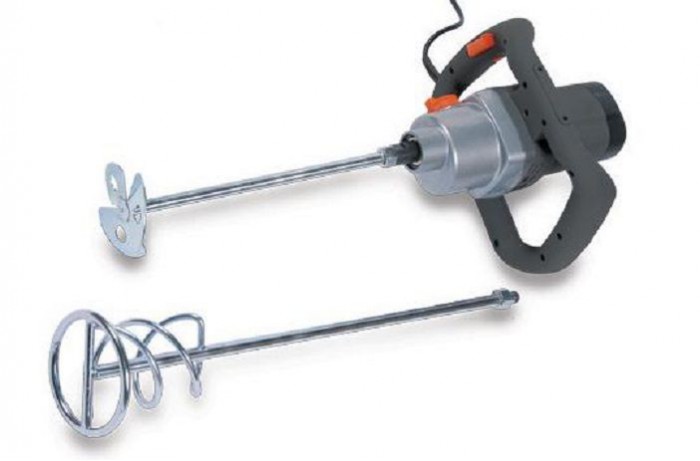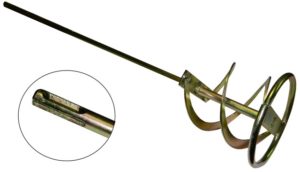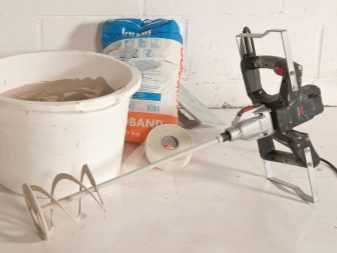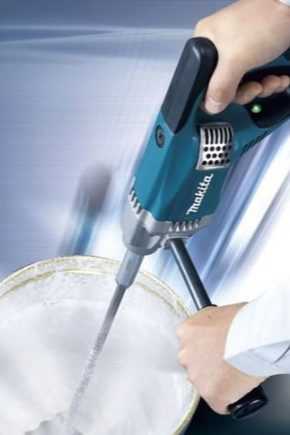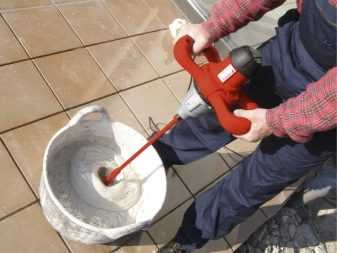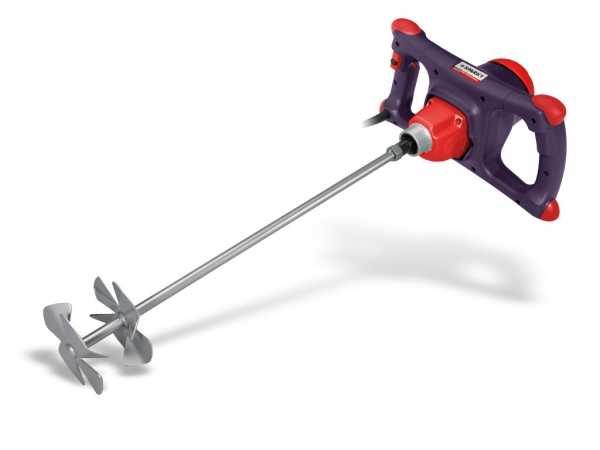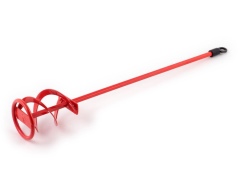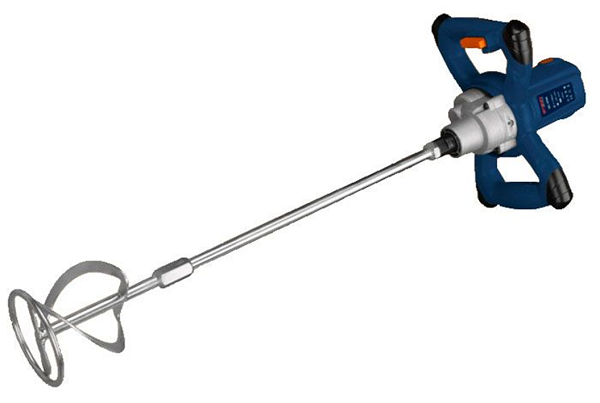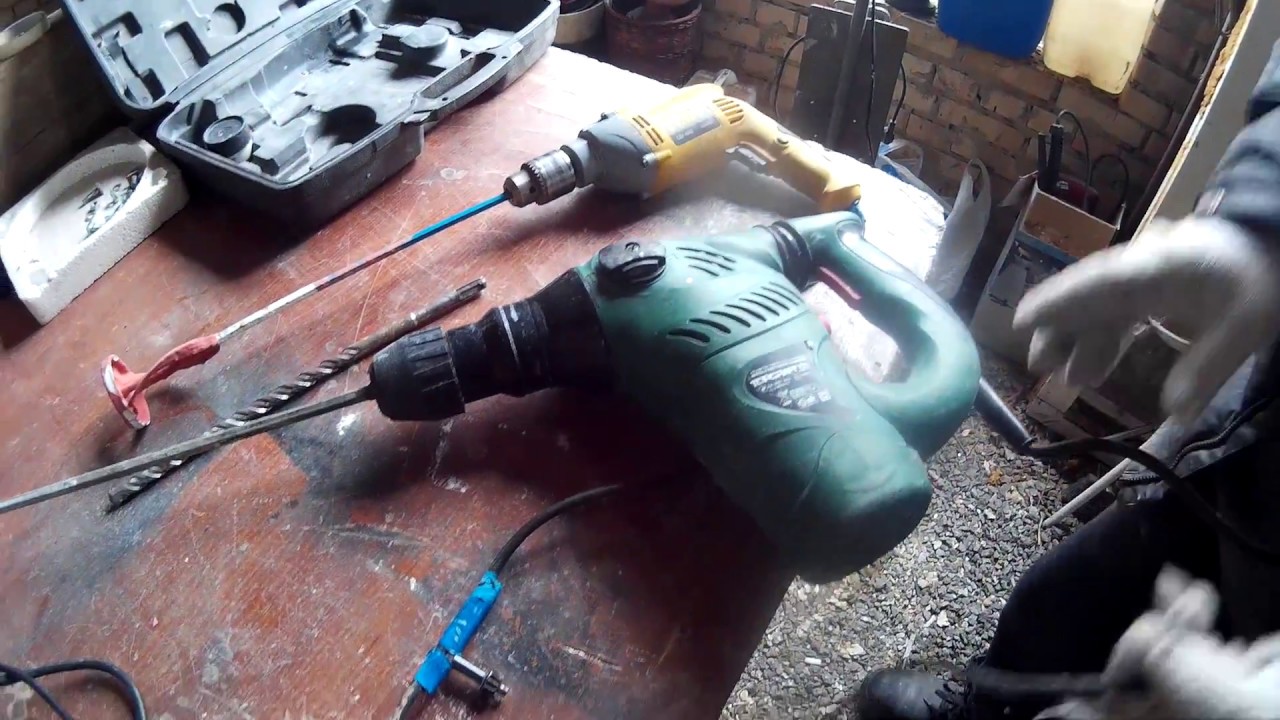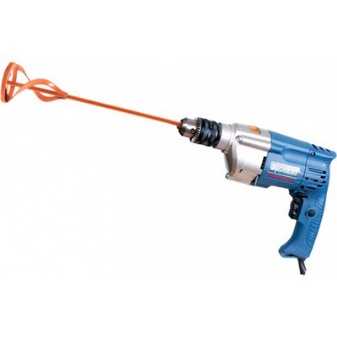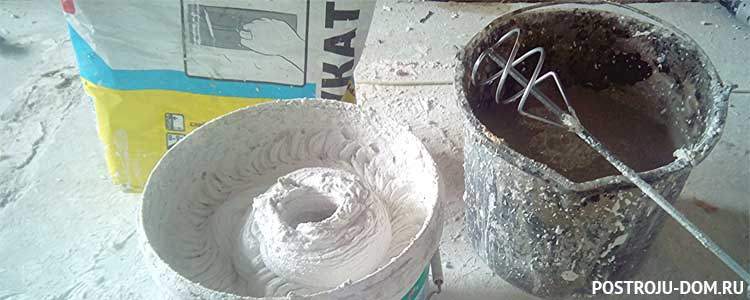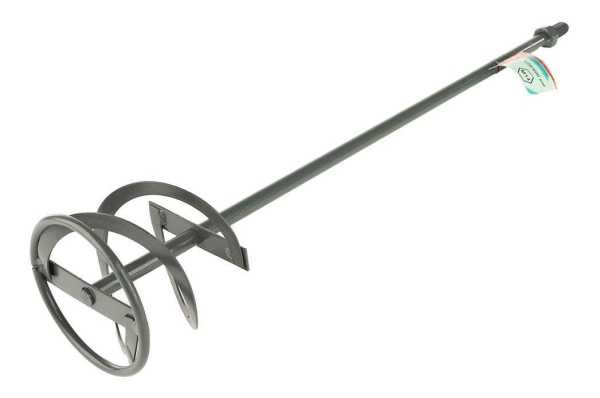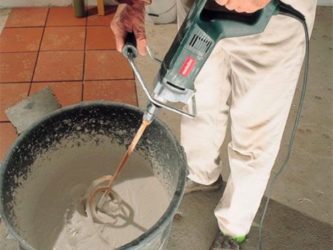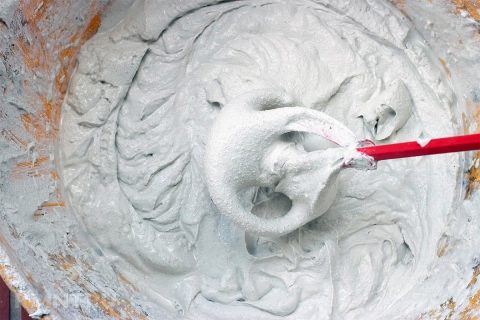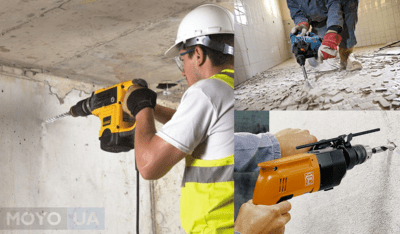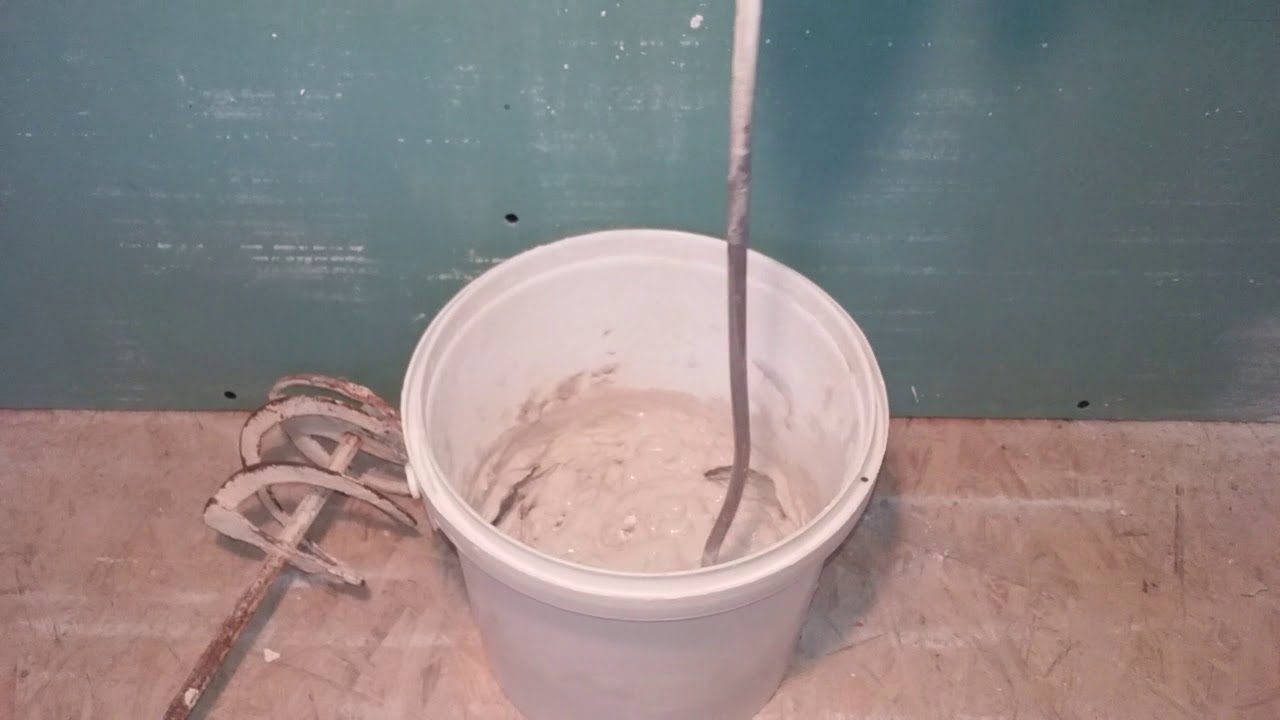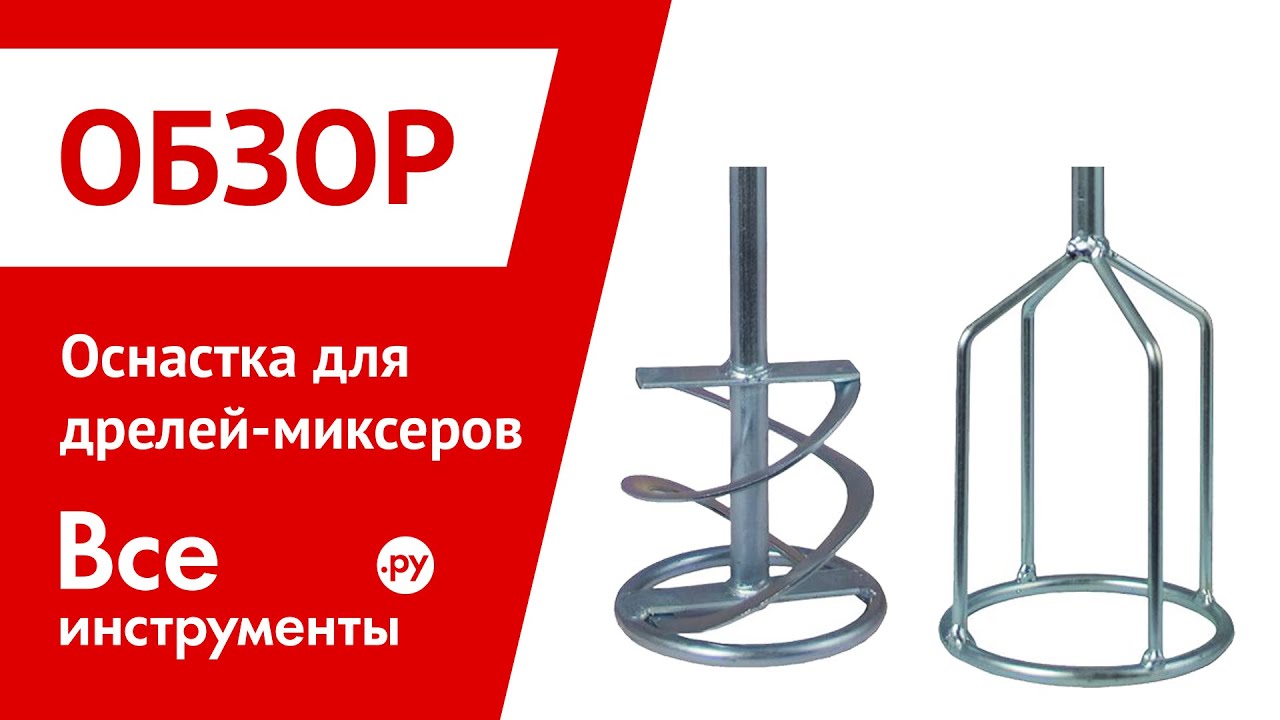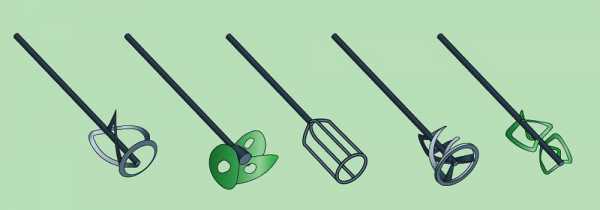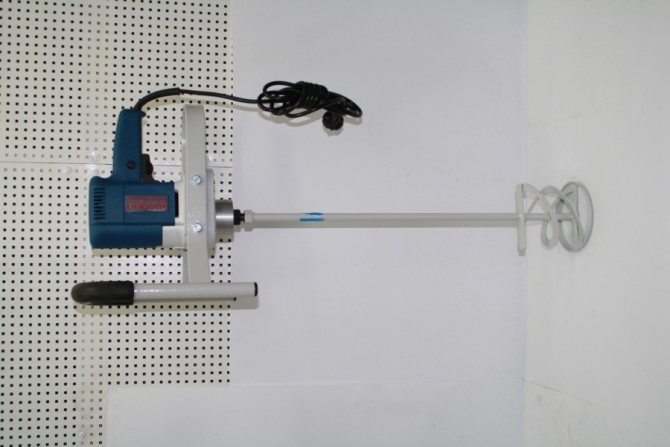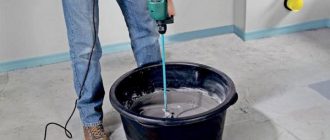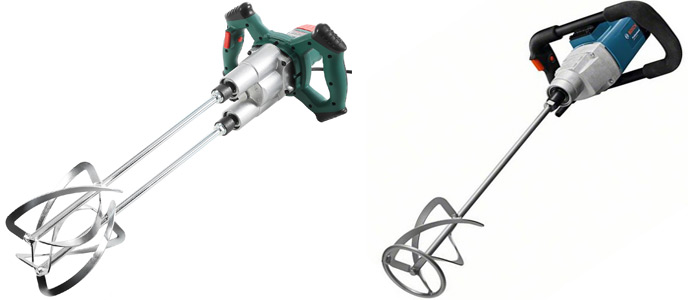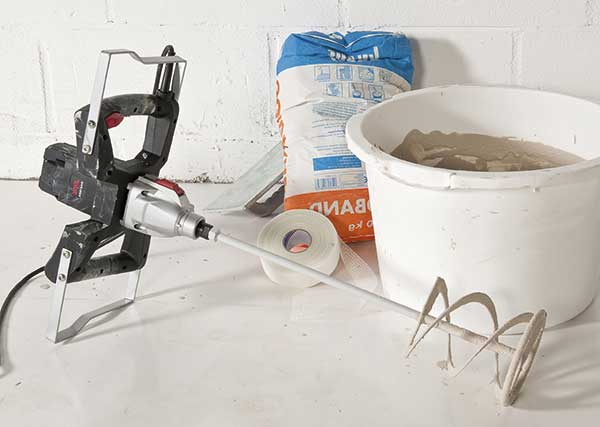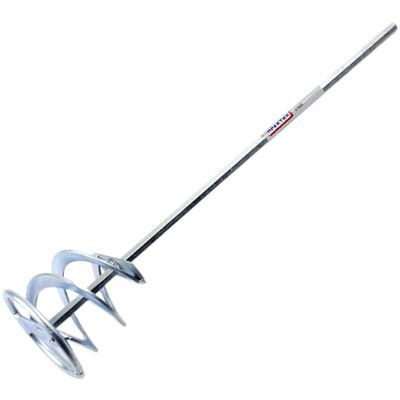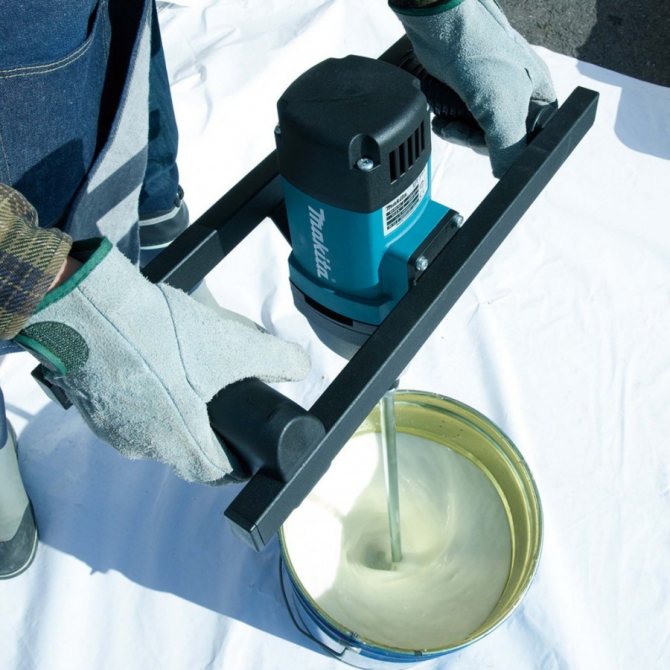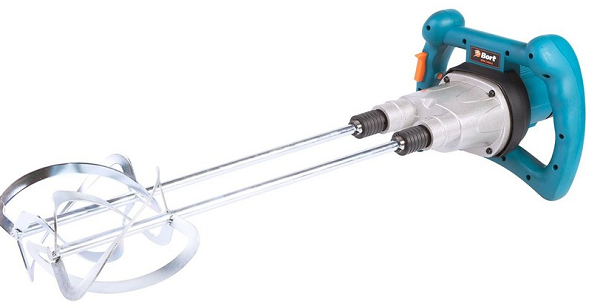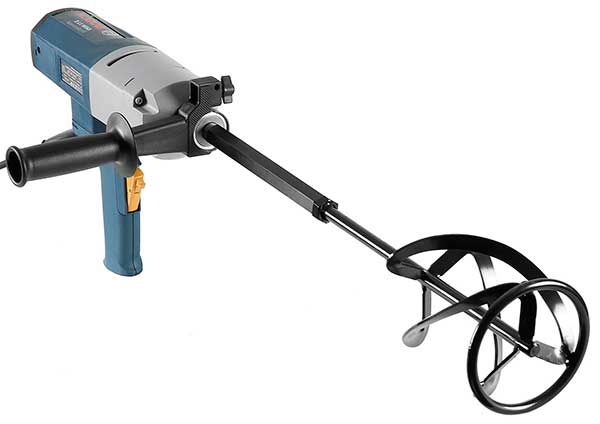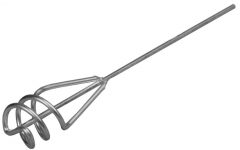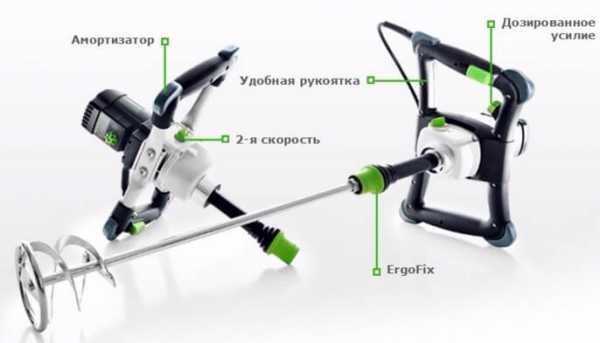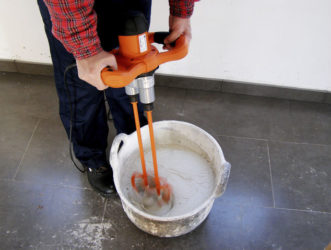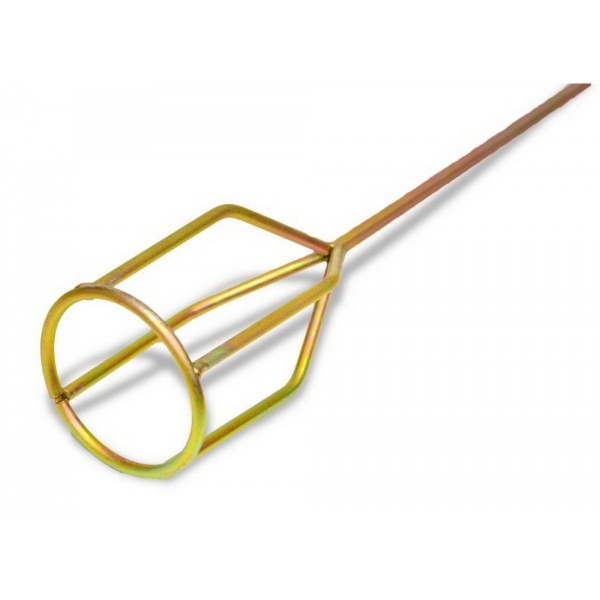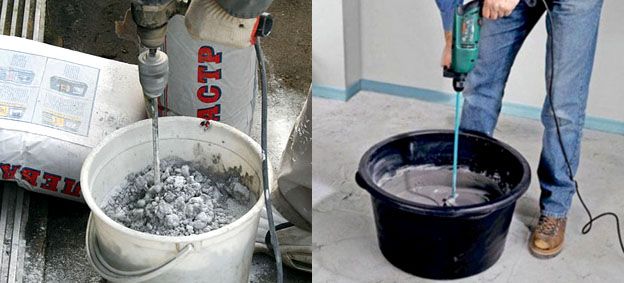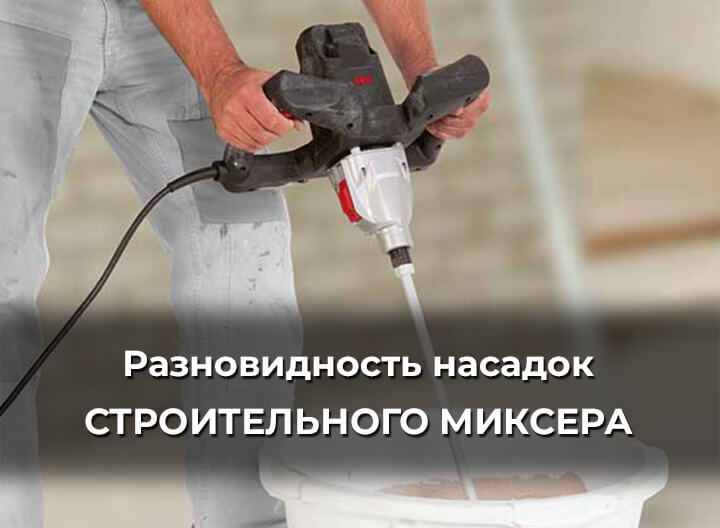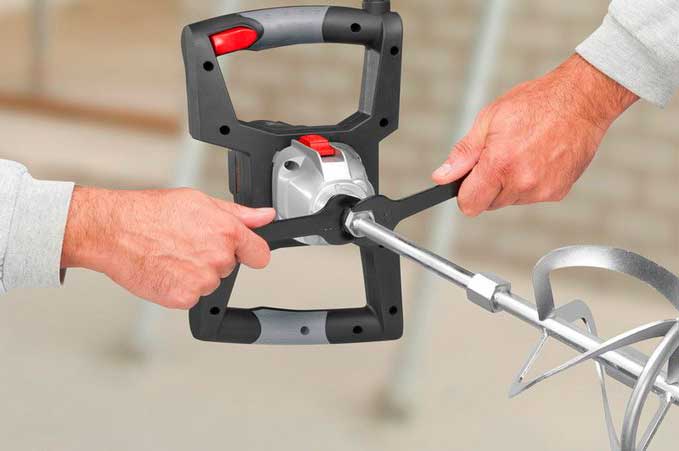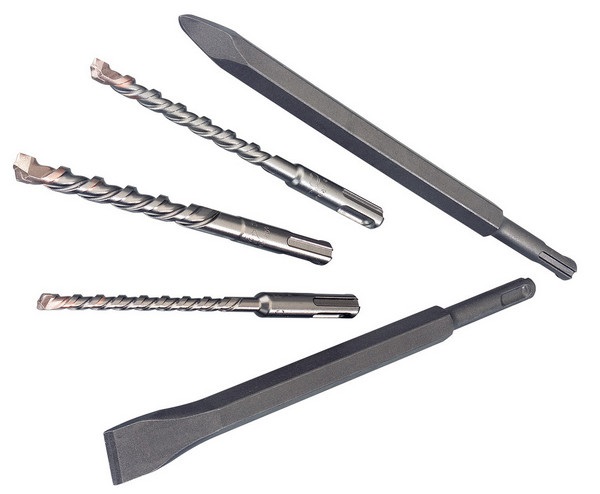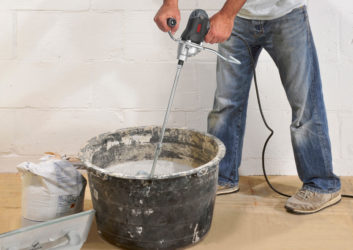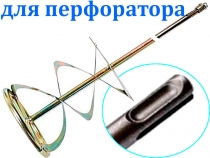Construction mixer attachments: shapes and sizes
An attachment for an electric construction mixer is a bar with a whisk at one end for mixing and a shank at the other end for attaching the attachment to the drive. After you have decided on the composition of the mixture to be mixed, you can choose the shape of the whisk. And the standard of the bit shank must match your power tool.
Types of shanks for mixer nozzles
Now on sale there are a large number of mixer attachments with shanks of various shapes:
- Regular hexagon, size 8, 9 or 10 mm. Such attachments are intended for use in a power tool having a conventional jaw chuck.
- Hexagon socket (8, 10 or 12 mm) with groove for spring fixing in HEX chucks (can also be used in power tools with a conventional chuck).
- Thread M12, M14 and 21X1.5. Attachments with such shanks can only be used in highly specialized mixers.
- Shanks designed to fit in SDS-plus chucks (can also be used in a simple rock drill).

Sizes and shapes of whisk nozzles for mixer
Mixing attachments are produced:
- Standard lengths 400 and 600 mm (for some extensions 400 mm are provided - total length up to 1 m).
- The diameter of the whisk (part intended for stirring) is from 80 to 220 mm.
The shape of the whisk is chosen depending on the mixture to be mixed. The main forms of corollas:
Spiral. Such corollas are subdivided into right-handed, in which the spiral is twisted clockwise, and left-handed, in which the spiral is twisted counterclockwise. Right-side beaters in the process of mixing raise the solution from the bottom up and are designed for heavy or thick mixtures (concrete, sand and gravel, bituminous). Left-handed spirals, on the contrary, while stirring, capture the mixture from above and lower it down. They are intended for mixing various paints and varnishes, various flowable mixtures and liquid fillers, since they do not splash when using them.
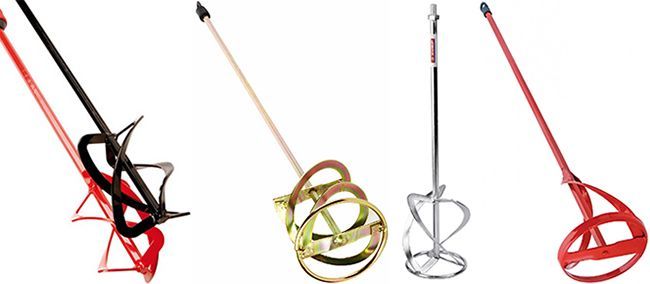
On a note! If the construction mixer is equipped with a reverse system that rotates the whisk both clockwise and counterclockwise, then only one nozzle (right-handed or left-handed) can be used for different mix compositions.
Corollas with straight blades. Stirring occurs only in the horizontal plane, which prevents air from being entrained and entering the mixture. Suitable for mixing various gypsum-based compositions (air ingress is highly undesirable), mixtures for self-leveling floors and the like.
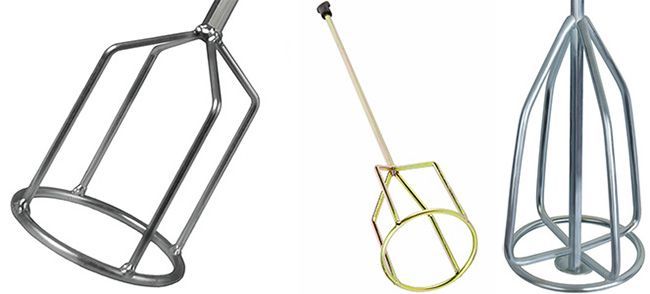
Screw-shaped beaters (the screw is usually made of plastic). Mainly used for light liquid mixture compositions. Sometimes two screws are installed on the axle: the lower one, which lifts the components up, and the upper one, which prevents the mixture from splashing.

Important! In the technical description, manufacturers indicate which type of mixture a particular whisk is intended for mixing, as well as the maximum recommended amount of solution for which it is designed. Depending on the size, materials and purpose, the price for these accessories is in the range of 100 ÷ 1100 rubles
Depending on the size, materials and purpose, the price for these accessories is in the range of 100 ÷ 1100 rubles.
Preparation of concrete by hand and using a drill mixer.
Household models are equipped with handles in the form of staples - ring version.For heavy-duty professional models, the handle is T-shaped. If the coating is anti-vibration and anti-slip, this makes the device more comfortable to use.
The package bundle also influences the choice of a suitable model. The kit includes a nozzle along with a device for fixing it. The attachment is done in different ways.
Threaded connection. The nozzle is screwed into the spindle with a threaded upper part. It is used in a professional tool, as it provides a secure fit.
Jaw chuck. It is used for drills - mixers and household electric drills. A special key is used to fix it in the chuck. Suitable for liquid, light and medium viscosity solutions.
SDS connection. Designed for rotary hammers. The attachment must be of a suitable design. It is used for mixing adhesives, plaster and putty solutions.
Keyless chuck FastFix. The system allows you to quickly change attachments by analogy with a screwdriver, but is not designed for frequent work with concrete mixtures - the edges of the cartridge are erased. If reverse is used, there is a danger of the tip unlocking.
Morse taper. The most reliable option, it allows you to work with compositions of any type. Used on professional models of the instrument.
In addition to buying the construction mixer itself, you need to take care of the choice of nozzles. Stirrer - propeller suitable for liquid formulations. The nozzle - a cross with vertical blades is used for mixing viscous and heavy mixtures.
The spiral left-side (moves the mixture down) and right-side (moves the mixture up) is used for compositions on a gypsum or cement basis and "light" concrete. The double-sided screw is designed for liquid and non-viscous mixtures. The universal auger is suitable for all types of mixtures.
Conclusion
When choosing a construction mixer, proceed from the spectrum and scope of work to be performed. For repairs, a household model is usually enough, for construction it is recommended to purchase a semi-professional mixer, choosing a tool with an optimal price-quality ratio.
Video on how to choose a construction mixer:
During repair work, it is often required to use a wide variety of manual, automatic or semi-automatic operations: chiselling, drilling, polishing, grinding, cutting, welding, etc. It is known that there is a specialized tool for each repair operation. It is not always necessary to perform these operations equally often: sometimes it happens that any repair operation occurs relatively rarely or even once. What to do then? Run out and buy the right construction tool for a one-time use? Borrow from neighbors, acquaintances or friends "for a couple of days"? Of course, there is a desire to use an existing tool in the work to replace the missing one.
The most common tool used in construction and repair work is the hammer drill. This power tool is owned by almost everyone who has had a repair at least once in his life. On the other hand, one of the most rarely used tools today is a construction mixer designed for mixing various construction and repair mortars. The reason for its rare use in repairs is a small, as a rule, amount of a solution stirred at a time (varnish, glue, etc.), in which it is quite possible to do without mechanization: stir it manually.
Nevertheless, there are cases when it is simply necessary to use electromechanical stirring: a very viscous medium, large volume, harmful environment, large mass of one batch, specificity of the process (uniformity, very fast or very slow shaft rotation, their combination), short terms demanding high performance, etc.
In all of the above methods, it is with a perforator that they are trying to replace the mixer with stirring. How justified is this? Is the hammer drill capable of performing a function that is not characteristic of its main application? We will try to answer all these questions in this article.
As you know, modern rock drills are capable of working in at least two modes: drilling and hammer drilling. It is also known that for drilling, an adapter (additional chuck) for drills is inserted into a standard SDS + chuck.
Additional recommendations
Using a perforator, you can mix a variety of substances:
- all types of plaster;
- cement;
- putty;
- tile adhesive.
When performing such work, it is unacceptable to use the shock mode. It is also unacceptable that the mixed liquid gets on the equipment. Both the perforator itself and the mixer, after the end of the work, must be thoroughly washed and dried at room temperature. This helps to extend the life of the device.
If the working part of the apparatus is clogged with glue, it is necessary to stop it, disconnect it from the mains and wash off the contamination. If you do not do this in a timely manner, you may be afraid of failure
It is imperative to ensure that the wires are in the correct position. Winding them on a whisk can result in serious injuries.
The perforator must be held firmly in your hands, not to be distracted by extraneous stimuli.
The number of revolutions is adjusted according to how deep the whisk is immersed. When mixed at full speed at the very top of the bucket, splashes are inevitable. As soon as the kneading is completed, reduce the speed and remove the whisk. Immediately immerse it in a bucket of clean water, and run it again for 2-3 seconds to completely cleanse. This technique allows you to re-prepare the instrument for work.
For information on how to choose a mixer, see the next video.
How to choose a construction mixer?
Therefore, the mixing attachment from the mixer is not difficult to insert. Further. Quite a few rock drills have a built-in mechanical gearbox that allows them to work at different speeds. Then, obviously, all the salt of performing a new function for a hammer drill is concentrated in its drive. All hand-held rock drills, as well as mixers, are equipped with a universal commutator motor, the rotation of the shaft of which is controlled by decreasing or increasing the supply voltage. Then the question comes down to the characteristics of these motors, the main ones of which are the maximum number of revolutions of the motor shaft, the power on the shaft and the torque on the shaft. Let's consider the operation of a perforator separately for two types of mixed media: low-viscosity and high-viscosity. Stirring a low-viscosity solution requires a small torque and different shaft speed. It is known that single-speed rock drills are operated by pulling the trigger, usually located in the handle of a power tool. Applying different pulling force on the trigger, we smoothly change the shaft (spindle) speed: with a weak push - low speed, and with a strong one - high up to the maximum.
The problem is that the speed lock, as a rule, only works when the trigger is fully pulled, that is, at maximum engine speed. This is very inconvenient when stirring. The way out, obviously, is the operation of such a tool through a step-down transformer (LATR can be used), the power of which must exceed or be equal to the power consumption of the hammer drill. In this case, the work of the hammer drill as a mixer has every chance of success.
In addition, there are now models of adjustable speed control rock drills that can also be used as agitators. It should always be remembered that the lower the power supply voltage of the rotary hammer motor, the lower the efficiency of such a motor.
The situation is more complicated with highly viscous media. Mixing them, as a rule, requires low speed and high torque. If the speed can be adjusted by connecting a step-down transformer to the perforator (as in the above-described case of working with low-viscosity media), then this will not work with the torque, since when the voltage supplied from the transformer decreases, the torque on the shaft drops along with the speed of the shaft (smooth characteristic) ...
It follows that working through a transformer (at low voltages) is beneficial only when the torque of the rock drill exceeds the required torque for mixing the medium, and this is not so common.Otherwise, the rock drill will need additional cooling (especially at low shaft speeds, at which the fan built into the engine does not create more or less normal air flow to the manifold of such an engine), since otherwise the overheating protection will work (the engine temperature sensor will turn off the power of the rock drill) ...
In addition to additional cooling, you can use some other techniques: reducing the diameter of the working part of the nozzle (This is one of the most effective ways to reduce the required torque!), Reducing the diameter of the container and / or the height of the stirred layer. A multi-speed rock drill is ideal. With it, you can work with viscous solutions at the first speed at low shaft speeds and at the second - with low-viscosity solutions at high speeds.
Let us consider the operation of a perforator in relation to high-speed mixing to obtain foamy solutions or fine suspensions and / or emulsions.
The typical maximum rock drill is about 1000 - 2000 rpm, which should be sufficient for most mixes in normal mode.
However, it is impossible to obtain high revolutions with the help of such perforators without the use of external mechanical gearboxes, since the operation of the engine is limited by the supply voltage (220 V). For rock drills with an integral gear, the maximum shaft revolutions will be equal to the highest gear ratio and at the maximum supply voltage.
Thus, the perforator can be used as a mixer. For slightly viscous media, an additional step-down transformer may be required, although this is not necessary. Highly viscous media may require additional engine cooling or more frequent pauses during agitation to cool the engine. For high-speed (very fast) mixing, exceeding the maximum rotations of the rock drill shaft, an additional external mechanical gearbox may be required.
6 Construction mixer, how to choose a manufacturer?
When choosing a brand of a construction mixer, it is worth proceeding from how large-scale repairs you are undertaking. If this is laying tiles in the kitchen or leveling the walls with putty in an average room (20-30 square meters), then not famous, but well-established brands are quite suitable: Torekh, Sturm, Interskol, Fiolent, Zenit
... If you have a small company engaged in turnkey repairs, which implies long-term, daily use, then, of course, an eminent brand will suit you - Bosch, Makita.
Now there are more than a dozen companies on the market (not only foreign brands, but also domestic manufacturers), offering a wide selection of construction mixers: from home and light mixers that are suitable for women painters to heavy twin-spindle units capable of "digesting" centners of building concrete.
Fiolent MD1-11E
It has already been noticed more than once that drills from manufacturers from the former Soviet republics are quite reliable, their functionality is also at a fairly high level. Interskol, Rebir, Rhythm and even Sparki can be referred to here - they make a worthy competitive instrument, but we just have a successful tradition of working with Fiolent. MD1-11E is a full-fledged mixer with a high-torque 1100 watt motor, although if you have a cartridge at hand (it is not included in the kit), you can drill with it. Everything is sound and solid: the plastic is good, the gear case is made of metal (aluminum alloy), so it cools well. With all the work for which he was taken, he copes without problems. I know for sure that some of my colleagues use such a mixer to prepare concrete, pour screeds from sand mortar in hectares, although we are not so extravagant and do not forget about concrete mixers. Moreover, while the loaded concrete mixer is doing its job by itself, you can do something else.
Fiolent MD1-11E
The device cannot be called a feather, its weight is 4.7 kg. However, MD1-11E is controlled quite easily, partly because its dimensions are rather modest (30 cm in length). Personally, it is very convenient for me to work with the trigger handle, the monumental metal handle-bracket is also, as they say, in its place. By the way, it comes in the kit and forms such a protective frame for itself - no matter how you put the tool, it will always rest on its metal. As an option, you can also purchase a special stand for this device in order to relieve your hands with large volumes. The start button is small - but it works responsively, allows you to "accelerate", of course, it locks in the pressed state.
The agitator is attached directly to the spindle, which has the most common M14 internal thread for mixers. The whisk must be purchased separately, but you can take exactly the one you need. The manufacturer recommends limiting yourself to a diameter of 140 mm.
As befits a professional mixer, in Fiolent MD1-11E, the rotational speed under load is electronically controlled and can be preset by a wheel-shaped regulator. The maximum possible spindle revolutions are few - 600 per minute at idle, but more is not needed.
A good machine for everyday work on the construction site. There are no serious bells and whistles in it - everything you need, but everything is on business. He has nothing to surprise an experienced builder with (but experienced builders do not like surprises), except perhaps with an adequate price for their characteristics. Spare parts are also inexpensive and affordable, although I haven't needed them yet. For a home craftsman, the 1050-watt model "Fiolent MSU9-16-2RE" is more suitable, we use this drill for light finishing work. It is lighter (2.4 kg), faster (two speeds: up to 800 and up to 2000 rpm), has a chuck and a long rotary handle. It's an all-rounder with a reverse and kick function available.
5 Can a construction mixer be replaced with a drill?
Drill mixers are often found on the market. As a rule, this is a conventional drill equipped with an additional handle or holders. With a small amount of work, this option seems optimal, as well as the cheapest option - to buy an auger and use it by inserting it into the chuck of a conventional drill or hammer drill. However, with a large amount of work and serious repairs, all the advantages of a real construction mixer make themselves felt.
A conventional drill is designed for completely different types of loads and operating modes. As a result, the spindle is often damaged. The motor of a standard drill and its control system, including speed control and reverse, are designed for a static load, i.e., roughly speaking, a straight line. When mixing a liquid medium, the moment of resistance of the mixture itself increases along a hyperbolic trajectory, mixer manufacturers certainly take this into account.
Concrete mixer
If masonry is required with seams of one centimeter or less, larger pebbles create problems during laying, preventing the brick from leveling with mortar.
I used an 8mm metal wire mesh stretched over a wooden frame. The frame was placed at an angle, and the sand was thrown through it. Before that I tried to pull a glass fiber mesh on the same frame, alas, it stretched out and broke after the first wheelbarrow of sand.

 My concrete mixer
My concrete mixer
The proportion of cement to sand was taken approximately 1: 4. Water was added by eye in such a way that the solution was not liquid, that is, it did not spread on a flat surface and at the same time was plastic enough, allowing the brick to be laid to be aligned.
The solution was mixed in a twenty-liter bucket from bitumen mastic using a drill and a special nozzle. We did not have a concrete mixer at that time and it is not quite suitable for preparing a small amount of masonry mortar.If you need a bucket or two at a time, then a concrete mixer is more problematic than efficiency, because it needs to be washed after use.
When mixing the solution with a drill attachment, the same is not all smooth. Neither the drill nor the hammer drill is designed for such a load. They warm up quickly and fail much faster, but having tried to mix sand with cement in a similar way, I do not want to return to the shovel at all. After all, the drill attachment whips the mixture much better, and you don't get tired at all when mixing.
When using nozzles for stirring the solution, you must be prepared for the fact that this product will break quite quickly. During the season, in two nozzles, the corollas worn off and fell apart, and in two more, the SDS cam fasteners broke off. They are not expensive, and given that they work in sand like in sandpaper, this is not so scary. More upsetting was the burned out, in the end, the Chinese drill, although of course we gave her the "tesu" for the construction. The DVT 750 W perforator seemed somewhat more tenacious, although the bearing and brushes had to be changed in it.
In the end, I found some compromise by using small diameters. Let them interfere longer, but the load on the drill is not so great, there is a possibility that the surviving hammer drill will last until the end of construction.
From the topic ⇒ Conclusion with a brick of the zero level of the tower
⇐ From the topic Raising the foundation line with a brick
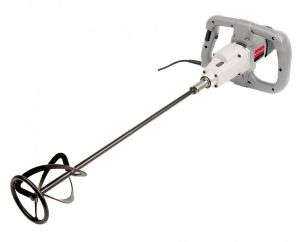 During the implementation of repair work, it is very often required to use a wide variety of manual, automatic or semi-automatic operations: chiselling, drilling, polishing, grinding, cutting, welding, etc. It is known that there is a specialized tool for each repair operation.
During the implementation of repair work, it is very often required to use a wide variety of manual, automatic or semi-automatic operations: chiselling, drilling, polishing, grinding, cutting, welding, etc. It is known that there is a specialized tool for each repair operation.
It is not always necessary to perform these operations equally often: sometimes it happens that any repair operation occurs relatively rarely or even once. What to do then? Run out and buy the right construction tool for a one-time use? Borrow from neighbors, acquaintances or friends "for a couple of days"? Of course, there is a desire to use an existing tool in the work to replace the missing one.
The most common tool used in construction and repair work is the hammer drill. This power tool is owned by almost everyone who has had a repair at least once in his life. On the other hand, one of the most rarely used tools today is a construction mixer designed for mixing various construction and repair mortars. The reason for its rare use in repairs is a small, as a rule, amount of a solution stirred at a time (varnish, glue, etc.), in which it is quite possible to do without mechanization: stir it manually.
Nevertheless, there are cases when it is simply necessary to use electromechanical stirring: a very viscous medium, large volume, harmful environment, a large mass of one batch, specificity of the process (uniformity, very fast or very slow shaft rotation, their combination), short terms requiring high performance, etc.
Advantages and disadvantages
The main advantage of the drill mixer is its multifunctional use. On the one hand, the tool is classified as a drill, therefore, in addition to mixing mortars, it can be used to form holes in surfaces of various types, even the hardest and most dense ones. On the other hand, a drill of this type belongs to the category of low-speed ones, therefore it cannot replace a drill by 100%, but at the same time, it is precisely low speeds that make it possible to mix even the most dense compositions.
Obviously, such a structure cannot be used in industrial volumes, its power and design features will not be enough to cope with an intensive mode of operation.But with the solution of small household tasks for minor repairs and decoration of an apartment or a private house, she will cope in full.
